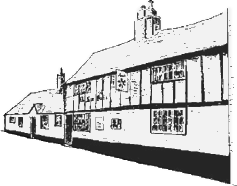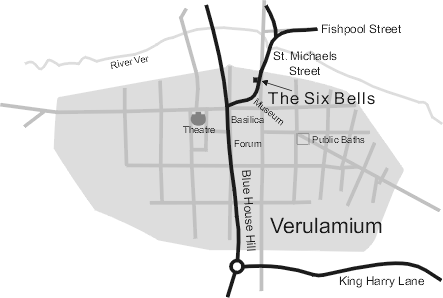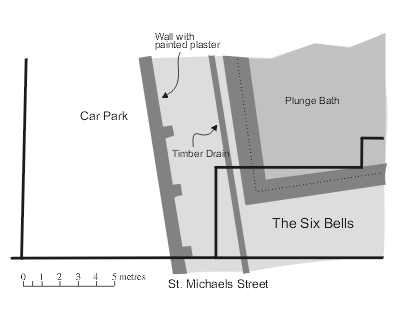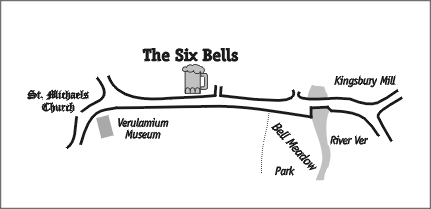|
Back to Archaeology & History Contents

(Background image -
gold coin of Cunobelin minted at Verulamium)
The Six
Bells
St.
Michaels Street
St. Albans


Providing
hospitality for over 400 years.
The only licensed house within
the walls of Roman Verulamium.

Plan
of Verulamium showing modern roads in black and the location
of The Six Bells
Beneath the Six
Bells
The Six Bells is the only modern licensed
premises situated within the walls of the Roman City of
Verulamium. Before the construction of an extension in 1974
and an enlargement of the Kitchen in 1991 archaeological
work revealed some very interesting results; most notably
the remains of a Roman Bath House which had been burnt down
by the followers of Queen Boudicca (Boadacea) in the revolt
of A.D. 60/61.
Prehistoric
Hunters
The earliest evidence of human activity
was a scatter of worked flints left by Mesolithic (Middle
Stone Age) hunter gatherers in the period 6,000 - 4,000
B.C.. The valley of the Ver, then much wetter than today,
provided a rich source of game, wildfowl, fish and other
food.
A Celtic
Mint
A large quantity of fired clay moulds
used in the production of blanks for Late Iron Age Celtic
coins of the local tribe, the Catuvellauni has been
recovered from the Six Bells. Analysis has shown that they
were used to mould gold, silver and bronze. Tasciovanus was
certainly minting coins at his capital, Verulamium, but
these moulds relate to his successor, Cunobelin (the
Cymbeline of Shakespeare). He was the most
powerful ruler in Southern Britain
and died in A.D. 40 not long before the Roman Invasion of
A.D. 43.
The Roman Bath
House
With the establishment of Roman
Verulamium around A.D. 50/55, a public bath house was
constructed alongside the street leading from the
"Colchester Gate" to the town centre. This was necessarily
built of flint and brick, and is the earliest known masonry
building at Verulamium. Unfortunately only a very small
portion, part of the frigidarium or cold room, of what must
have been a large building is known. Its quality was shown
by fragments of finely painted plaster one of which
displayed a tortoiseshell lyre, a bow and a quiver of
arrows, the attributes of the god Apollo. Some plaster
remained at the bottom of an internally buttressed wall and
this was stippled to imitate panels of marble. This
plastered wall flanked a walkway around a substantially
built plunge bath which when in use held a depth of 1.2m
(4ft.) of cold water. In the revolt of A.D. 60/61 the
building was seriously damaged by fire but was subsequently
reused, although in a rather tatty condition, while a new
public baths was constructed elsewhere in
Verulamium.

Plan of the Roman Bath
House
"Le Bell in St.
Michaels"
In 1543 an entry in an Estate Roll of the
Manor of Gorhambury refers to a Bell Croft and in 1596 there
is reference to "Le Bell in Saint Michaels". It would seem
that the house originated as an alehouse with land attached,
the tenants making a living from some form of agriculture as
well as from the victualling trade. Part of nearby
Verulamium Park is still called by some local inhabitants,
Bell Meadow and this no doubt formed part of the
landholding. The present building is of late 16th or 17th
century date and has been altered over the course of time.
In 1628 the St. Michaels churchwardens accounts record "For
bread and beer at the sign of ye Bell in St. Michaels Street
the first day we went on procession 2s. 11d". (14.6p). The
£1-10-0 (£1.50) parish rate paid by the Bell in
the 18th century was 6 times more than the sum paid by the
next valued licenced house. This may mean that it was of
higher quality than its rivals in the parish, or perhaps it
still owned an amount of land. In 1756 The Six Bells could
provide 2 beds for travellers and stabling for 9 horses, for
like other alehouses at this time food and accommodation
were provided although it never obtained the full status of
an inn. At some time between 1769-86 the number of bells in
the nearby St. Michaels Church was reflected by a change in
the name of the house to The Six Bells. In the early 19th
century it bore the nickname "The Ringers".
St. Michaels Church
Bells
When the church first had bells is
unknown although a "new bell" was recorded in 1428. In 1552
there were 4, and also a sance or sanctus bell. In 1628 one
of the main 4 was recast to form a "Great Bell". A church
inventory of 1638 recorded 5 bells, with ropes to them, one
of which was presumably the sance. In 1700 the church had
only 4 bells. In 1739 these were recast into the 6 bells
from which the pub gets its name: 2 of these 6 were recast
in 1897/8. If the name of the pub had kept up to date it
would now be The Eight Bells for in 1953, to celebrate the
coronation of Queen Elizabeth II, two new bells were
hung.
St. Michaels
Street
The street once formed part of one of the
busiest roads in England&emdash;the London/Chester/Holyhead
road. By the 9th century the Roman Watling Street had been
diverted from its course through Verulamium to pass around
St. Albans Abbey, effectively creating the road from the
town to St. Michaels - George Street, Fishpool Street and
St. Michaels Street. The road then continued along part of
what is now Gorhambury Drive and then along its old Roman
course to Dunstable and beyond. In the 12th century a new
way from London became favoured and entered St. Albans via
Sopwell Lane. With the improvement of roads with the
turnpikes of the 18th century the present London Road was
cut into the town in 1796.
On the St. Michaels side of the town it
was not until Verulam/Redbourn Road was opened in 1826 that
the "circuitous narrow and low state of the road" from St.
Michaels Bridge was bypassed, as part of Telford's
improvement of the Holyhead Road. So the constant stream of
traffic was removed from St. Michaels Street. It was
estimated in 1815 that 70 mail and stage coaches coaches
passed daily through St. Albans and that these along with
travellers on foot accounted for over 1,000 people passing
through the town each day. Most of these would have
travelled on this road. The St. Albans Turnpike Trust,
established in 1715, had built in 1765 at a cost of
£280 St. Michaels Bridge over the River Ver and this is
now the oldest extant bridge in Hertfordshire.
In the earlier Middle Ages the street was
called Kingsbury Street but was known by its present name by
the end of the 15th century. It was not until 1835 that this
area was incorporated into the Borough, later the City, of
St. Albans and even today is still referred to locally as
"the village".

Map showing the
Location of The Six bells
Go to the Verulam
Arms, the Tudor
Tavern,The
Boot. or the White
Hart
Back to Archaeology & History Contents

|